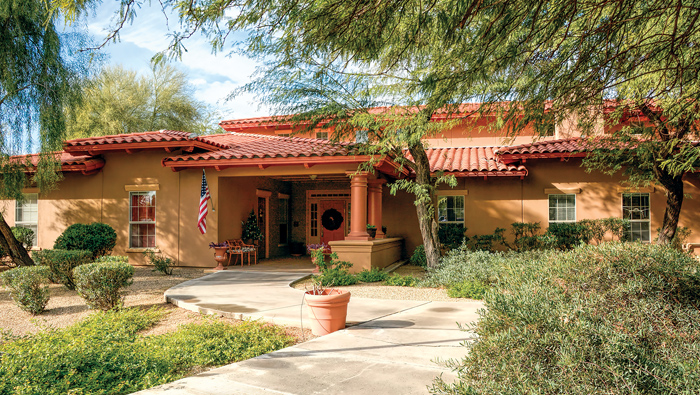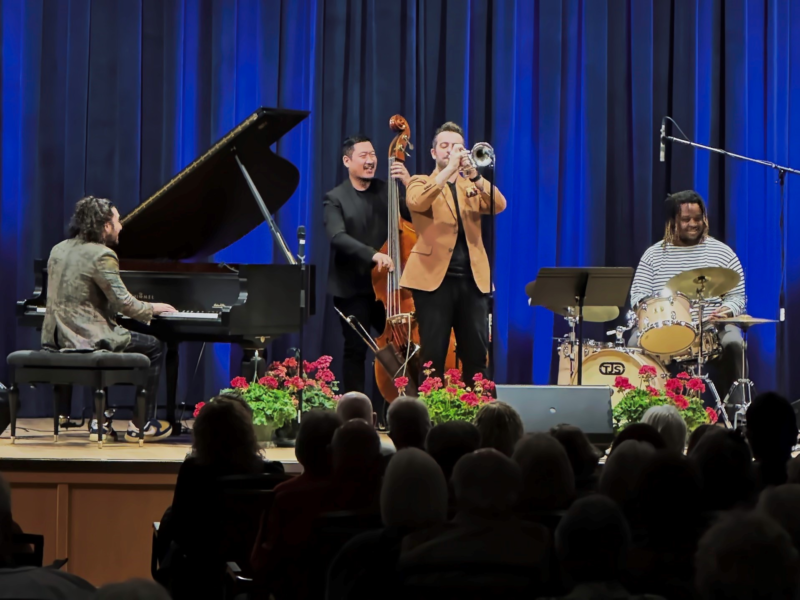The first thing you notice when you walk up to Barton House is what it’s not. The architecture is not what you might expect from a memory care facility, where senior residents are coping with dementia and Alzheimer’s disease. It’s not stark and institutional looking. What you do notice is that it looks like a house and a home – which is exactly what it is.
The two buildings that make up Barton House are tucked away on East Mountain View Road in Scottsdale, under the shade of mature, manicured desert landscaping. House I was built in 1999, at a time when there were very few options for seniors with memory issues like Alzheimer’s and dementia. They were simply locked up in skilled-nursing facilities with wards that kept them sequestered from the outside world. House II was completed in 2010. Both houses share the same campus and each has 20 private rooms with half baths.
“They’re called houses for a reason,” says Randy Farmer, director of marketing at Barton House. “The original builders wanted a different model with a warm, homelike environment.”
The original builders were an unlikely pair, in light of their relative youth compared to those they sought to serve. Two Austin businessmen named Bob Bouchard and John Trevey became co-owners of the first Barton House in the mid-90s. Their goal was to revolutionize society’s approach to “memory care,” a higher level of specialized care for those with degenerative brain diseases like Alzheimer’s and dementia that differs from traditional nursing homes and hospitals. A nationwide search convinced them that there was a critical lack of understanding of how to interact with and care for these seniors.
Eventually, there were 11 independently owned Barton Houses across the country. The one in Scottsdale was acquired in 2005 by Kleege Enterprises, a commercial real estate company in San Diego.
SOBERING STATISTICS ON ALZHEIMER’S
“Memory care is a calling,” says Randy. “You truly have to want to work in this environment. It’s tough and demanding emotionally. We recruit people who want to be here.”
Randy says that memory care, including continuing care retirement communities, has expanded exponentially over the last decade, especially with the incidence of Alzheimer’s disease rising with the aging U.S. population. He stresses that there is a broad spectrum of quality and aesthetics in the market, ranging in cost from $3,500 to $11,000 – per month. Each facility has its pluses and minuses, but “ambience does not equal level of care,” says Randy. At $5,500 a month, Barton House falls below mid-range but assures low resident-to-caregiver ratios with a maximum of six to one and low staff turnover attributed to its unique culture of caring.
The Centers for Disease Control cites that Alzheimer’s is the sixth-leading cause of death in the U.S. and that one in three seniors dies with Alzheimer’s or some kind of dementia.
More sobering statistics from the Alzheimer’s Association:
• 1 in 9 Americans over age 65 has Alzheimer’s disease
• One-third of Americans over age 85 are afflicted with
the disease
• 5.3 million Americans are living with Alzheimer’s
• By 2050, that figure could rise as high as 16 million
• In 2017, Alzheimer’s and other dementias will cost the
U.S. $256 billion
As the single senior care center in the Kleege portfolio, Barton House is not under the relentless pressure of occupancy and profit margin of corporate owners of senior care centers. Still, he admits, “it is labor and cost intensive. It is a business with an altruistic and a balance-sheet side – and the balance sheet has to work.” Resources for certain seniors and veterans, long-term care insurance, retirement savings, investment income and family financial support can help make living in a place like Barton House – and the accompanying peace of mind – attainable.
STAYING AT BARTON HOUSE UNTIL END OF LIFE
Randy cites Barton House’s own approach to engaging with and caring for residents and stresses the importance of “understanding each individual and how to deal with the rest of [his/her] core personality.” While social behaviors and norms get stripped away by these tragic degenerative brain diseases, Randy is resolute about the need to treat each person as if that core personality is still there.
“We love on them, we take care of them, keep them alive and engaged and in touch with their personalities [as much as we can] until it’s no longer possible,” says Randy.
Barton House works to facilitate all of the necessary support services for its residents, including the coordination of medical care, physical therapy, mobile medical and dental care and hospice. “We have three physicians who come see our patients – and any primary care doctor is welcome [to come see a patient].” An ongoing goal is to keep residents out of the hospital and the ER. “We care for and support our residents as fully as possible and help them stay at Barton House until end of life,” says Randy. The only limits are placed on behaviors that are threats to residents and staff.
Residents enjoy three home-cooked meals a day in the Barton House dining room. (Randy says that although the kitchen is not kosher, they can provide kosher meals for Jewish residents.) There are no hallways by design, because they can be confusing to residents. All rooms open onto common areas – no one is “locked away.” The backyard is spacious, with grass and native foliage and a patio for gatherings. Residents enjoy regular musical entertainment and students from Chaparral High School, just a stone’s throw away from Barton House, engage with residents through community service programs. Randy recalls the day a group of students descended upon both Houses I and II to play the piano and help with crafts. “The energy level was way up for two hours,” says Randy.
Randy can thank his wife Stephanie for helping pave his way to Barton House. An avid advocate for seniors, she has worked in the senior-living industry since 2001 and saw her mother through a 15-year Alzheimer’s journey. “She has been my mentor,” says Randy. But though Randy says he “tried to retire twice – it didn’t work,” he already had the tools to fill his current position (in November 2016) after a 40-year career in sales and marketing in the healthcare industry, which allowed him to raise the level of his position at Barton House.
ONE OF THE MOST DIFFICULT DECISIONS IN LIFE
There is no barrier to family accessibility at Barton House. Without set visiting hours, family members and spouses can come and go 24/7. “We do not close and we do not restrict access,” says Randy. “We can best help families to the degree that they want to be integrated into the Barton House family.” Partners include the Area Agency on Aging, Jewish Family & Children’s Service and other social service agencies. Staff also provide individual coaching and counseling to spouses and adult children of residents.
Abandonment, guilt, separation – Randy sees the full range of emotions when it comes time for “one of the most difficult decisions a family has to make in life. We work very hard to support them. We show compassion, a willingness to hold their hand, pat them on the shoulder and help them through the challenge.”
The essence of Barton House comes down to what Randy calls “accepting residents at their level, whatever it is, and validating that individual as a real human being. You cannot be angry or frustrated or anything other than kind, because they are so lost and helpless and dependent on those who care for them.”
Randy has learned higher levels of patience, kindness, service and humility at Barton House. “I have become a much more grateful human being in the short time that I have had the pleasure and privilege to work with this group of individuals,” says Randy. “This job can break your heart, but it can also be a source of great joy.”
Barton House is located at 7007 E. Mountain View Road in Scottsdale. For more information, call 480-991-9912 or visit thebartonhouse.com.
Mary Ann Bashaw, of Phoenix, is an editor and writer.






